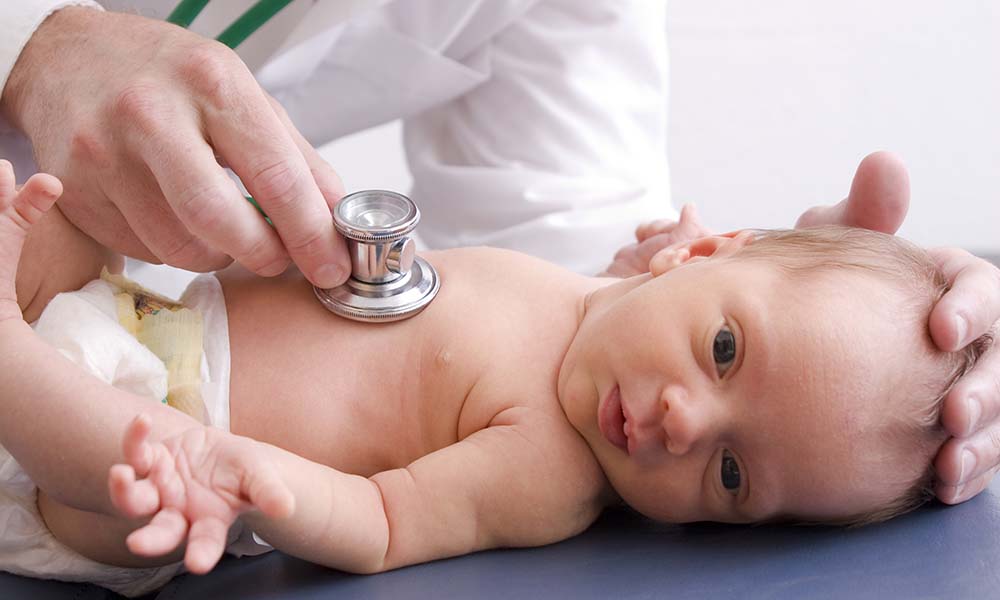Foetal Congenital Heart Defect: Diagnosis, and Treatment

Do you know heart defects are the most common type of defects that one has since birth? Approximately more than 200,000 babies are born with heart defects in India.
A baby’s heart starts to form just weeks after conception. While most hearts develop normally, congenital heart defects (CHDs) can sometimes occur, affecting the structure and function of the baby’s heart. These conditions can potentially present a risk to an infant’s life, but with early congenital heart defects diagnosis and modern fetal treatments, outcomes can be improved.
Is it really possible to diagnose and treat congenital heart defects in fetuses? Let’s explore the diagnosis and treatment options available for foetal congenital heart defects.
What Is a Foetal Congenital Heart Defect?
Fetal CHDs or congenital heart defects are problems with the fetus’ heart structure. Here, ‘congenital’ means that the heart defects are present at birth. These defects develop when an infant’s heart fails to develop normally during pregnancy.
Usually, congenital heart defects develop in fetuses during the first eight weeks of pregnancy due to various factors, such as genetic conditions like Down syndrome or mutations in specific genes, mothers having diabetes, infections or obesity, and exposure to harmful chemicals like alcohol, tobacco, etc. These heart defects can vary in severity, with some changing how the heart pumps blood. They can either block the blood flow, slow it down, or divert its way.
There are many types of heart defects that can happen in one or more parts of the foetus’ heart, and the most common types are the following:
Septal Defects | These congenital heart defects are characterised by the hole in the wall between the right and left sides of the heart. |
Defects in the Large Blood Vessels | There could be defects in the large blood vessels that are responsible for carrying blood in and out of an individual’s heart. |
Heart Valve Defects | These heart defects include problems with the heart valves that control blood flow through the heart. |
Diagnosis of Fetal Congenital Heart Defects
Is it possible to diagnose fetal congenital heart defects? If yes, are you curious to know how to diagnose congenital heart defects in fetuses? Let’s learn how congenital heart defects are diagnosed in foetuses:
Diagnosis of Foetal Congenital Heart Defects Before Birth
Prenatal diagnosis of congenital heart defects is possible and allows healthcare providers to plan for immediate care after delivery, improving outcomes. The following two methods are usually used to diagnose congenital heart defects in the foetus before birth:
Echocardiogram: Your healthcare provider might use a specialised ultrasound, i.e., a fetal echocardiogram for heart defects. It’s typically performed between the 18th and 22nd weeks of pregnancy. This specialised ultrasound equips the provider with detailed images of the fetal heart, which allows them to examine the heart’s chambers, valves, and blood flow and identify potential abnormalities.
Genetic Testing: Apart from echocardiograms, now many healthcare professionals suggest conducting genetic testing to diagnose potential genetic reason for congenital heart defects in fetuses. For instance, amniocentesis or non-invasive prenatal testing (NIPT) might be conducted if there are indications of chromosomal abnormalities linked to heart defects.
Diagnosis of Fetal Congenital Heart Defects After Birth
Usually, all newborn babies are checked for congenital heart defects via a series of tests. First, pulse oximetry, a non-invasive test, is performed to measure oxygen levels in the blood. A healthcare professional clips a pulse oximeter to the baby’s hands or feet to determine blood oxygen. If it’s too low, more tests are performed to find out whether the baby has a congenital heart defect.
Echocardiography is also performed after birth to provide a detailed view of the heart’s structure and function. In addition, the following diagnostic tests might be performed:
A physical exam
Certain heart tests to determine how a baby’s heart is functioning
Chest X-rays or cardiac MRI to confirm the diagnosis or evaluate the defect’s impact on the baby’s lungs and other organs.
Blood tests and genetic evaluations rule out associated syndromes, conditions, or gene problems potentially causing the heart defect.
Treatments for Congenital Heart Defects in Fetuses
Usually, fetal heart defect treatment can lead to excellent results when provided after birth.
However, a few severe heart defects can not be possibly addressed and correctable after birth. They may need one or more open heart surgeries, which, even if performed successfully, can result in abnormal circulation or long-term limitations.
Let’s learn treatment options for heart defects in fetuses both before and after birth:
Treatments for Foetal Congenital Heart Defects Before Birth
Fetal Cardiac Interventions: It’s rare for doctors to perform fetal cardiac interventions to correct or mitigate heart defects while the baby is still in the womb. But procedures like fetal balloon valvuloplasty are used to treat conditions like critical aortic stenosis by inserting a tiny balloon catheter through the mother’s abdomen and into the baby’s heart to open narrowed valves. In some cases, in-utero stent placement might be used to improve blood flow, particularly in conditions like hypoplastic left heart syndrome.
Maternal Medications: Doctors might also prescribe certain medications for mothers to manage fetal arrhythmias or improve blood flow, aiding the baby’s heart to pump at normal rate and rhythm .
Treatments for Fetal Congenital Heart Defects After Birth

Most congenital heart defects are treated after the baby is born, with doctors tailoring treatment approach depending on the heart defect and baby’s general health:
Medications: Often, doctors prescribe medications for mild congenital heart defects or as a temporary measure before surgery. These drugs are administered to help manage symptoms such as fluid retention, irregular heartbeats, or low oxygen levels. For instance, angiotensin-converting enzyme (ACE) inhibitors or beta-blockers might be prescribed for blood pressure, and water pills (diuretics) might be prescribed to help remove fluid from the baby’s body.
Cardiac Catheterisation: Some congenital heart defects in infants are repaired via cardiac catheterisation. The healthcare professional inserts one or more thin, flexible tubes, called catheters, through a blood vessel, often in the groin, and guides the same to the baby’s heart. Once in place, the professional threads tiny tools via a catheter to fix the heart defect. For example, holes in the heart or narrowed areas can be fixed through cardiac catheterisation.
Heart Surgery: Surgical repair is often necessary for complex congenital heart defects like Tetralogy of Fallot or Transposition of the Great Arteries. Surgical procedures might be performed to patch holes, reconstruct arteries, or repair valves. Moreover, multi-stage surgeries such as the Norwood procedure might help treat severe heart defects, such as hypoplastic left heart syndrome, by ensuring proper blood flow.
Heart Transplant: Is your baby’s heart too damaged to repaired? In such a case, your baby might be advised to undergo a heart transplant as the only option.
To Sum Up It All!
Having congenital heart defects in fetuses can be dreadful, but with early diagnosis and the best treatment for fetal heart defects, you can potentially ensure the proper development of your baby. But parents should also know that one procedure or surgery might not be enough for some kids born with congenital heart defects. They might need to undergo multiple medical or surgical treatments throughout life. In addition, life-long follow-up, including regular health checkups and monitoring by a cardiologist, is important.
If you want your foetus to get checked and treated for congenital heart defects, book your appointment with professional fetal medicine specialist at Medanta today!
FAQs
1. How do doctors initially suspect a congenital heart defect in a fetus?
Doctors may suspect a congenital heart defect during a routine prenatal ultrasound if they notice abnormalities in the fetal heart structure or function.
2. What is a fetal echocardiogram?
A fetal echocardiogram is a specialised ultrasound used to get detailed images of a fetus's heart to diagnose congenital heart defects.
3. At what stage of pregnancy can a fetal echocardiogram be performed?
It is typically performed between 18 and 24 weeks of pregnancy when the heart's structure is more developed.
4. Can genetic testing help diagnose congenital heart defects?
Yes, genetic testing can identify chromosomal or single gene disorders linked to congenital heart defects.
5. Are all congenital heart defects treatable before birth?
Some minor defects may not require immediate treatment, while severe cases may need interventions after birth. Rarely, in-utero procedures are performed.
Citations
Congenital heart disease in India: a status report. (2018, December 15). PubMed. https://pubmed.ncbi.nlm.nih.gov/30745481/
Halder, V., Ghosh, S., Shrimanth, Y. S., Manoj, R. K., Mandal, B., Thingnam, S. K. S., & Kumar, R. (2021, October 25). Fetal cardiac intervention and fetal cardiac surgery: where are we in 21st century? https://pmc.ncbi.nlm.nih.gov/articles/PMC8611270
Sun, H. Y. (2021). Prenatal diagnosis of congenital heart defects: echocardiography. Translational Pediatrics, 10(8), 2210–2224. https://doi.org/10.21037/tp-20-164
Uebing, A. (2006). Pregnancy and congenital heart disease. BMJ, 332(7538), 401–406. https://doi.org/10.1136/bmj.332.7538.401


